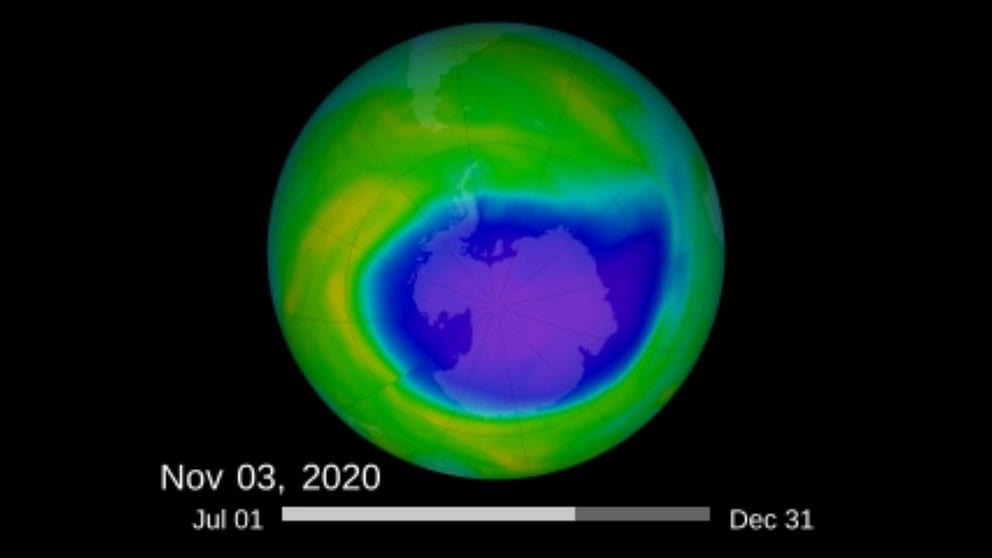Ozone layer regulations will prevent 443 million cases of skin cancer in the US, EPA says
Computer models show the ozone layer healing itself by the end of the century.
The EPA estimates that almost a half-million cases of skin cancer, 2.3 million skin cancer deaths and 63 million cases of cataracts have and will be prevented by the Montreal Protocol regulations on ozone-depleting chemicals.
The Atmospheric Health Effects Framework (AHEF) computer model calculated the expected number of new skin cancer cases, skin cancer deaths and cataracts in the U.S. before the Protocol and compared the numbers to the number of each expected after the policies took effect for people born between 1890 and 2100.
The ozone hole over Antarctica
NASA animated the seasonal progression of the Southern Hemisphere ozone hole from July to December 2020.
Montreal Protocol
"In the late 70s, people realized that these manmade chemicals, chlorofluorocarbons, were destroying the ozone and the ozone layer," said Nancy Akerman, Ph.D. and Environmental Policy Analyst for the Environmental Protection Agency (EPA). "The world came together, and in 1987, they created the Montreal Protocol on Substances that Deplete the Ozone Layer. And the ozone layer is on its way to recovery."
The EPA estimates that the ozone layer will naturally recover to its pre-1980 levels by 2100.
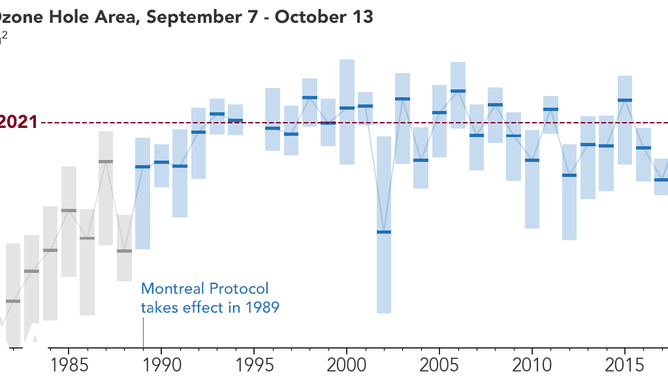
"This chart depicts the average extent of the Antarctic ozone hole during peak ozone depletion season from 1979 to present. Scientists said the 2021 ozone hole would have been 1.5 million square miles larger if atmospheric chlorine levels today were as high as they were in the early 2000s."NASA
(NASA)
The Montreal Protocol, ratified by all United Nations countries, stopped the production of ozone-depleting chemicals and phased out their use. Initially, most chemicals were chlorofluorocarbons (CFC) used for refrigeration and air conditioners, fire extinguishers and foam making.
Further amendments limited hydro chlorofluorocarbons (HFC) which were developed to replace CFCs.
"The parties agreed that they should also phase down, not out, the latest class of substitutes, which are the hydro fluorocarbons or HFCs," said Akerman. "They're still ozone-depleting, but they don't have as much ozone depletion power as the CFCs."
"Actually, the HFCs are not really thought of generally as ozone-depleting substances, but they were very high greenhouse gases," added Akerman.
Greenhouse gasses trap heat in the atmosphere similar to the way windows in a greenhouse allow the sun's UV radiation to be absorbed by the Earth but don't allow the heat to radiate out.

Over 30 years of satellite images (1979-2012) taken each October over the Southern Hemisphere show the thinning ozone layer in blue.
(Photo by: Universal History Archive/ Universal Images Group via Getty Images / Getty Images)
What is the ozone layer?
The stratosphere's ozone layer, where 90% of the Earth's ozone sits between 6 miles and 31 miles above the surface.
The naturally occurring gas contains three oxygen molecules and filters out the sun's ultraviolet radiation (UVC rays and some UVB rays). UVA rays penetrate and damage the middle layer of skin while the more energetic UVB hits the outer layer.
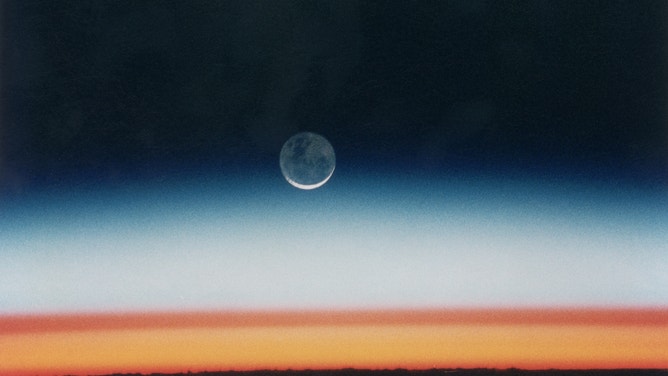
This photo of the moonrise taken by the space shuttle Columbia shows the dark Earth, reddish troposphere and whitish stratosphere. All weather occurs in the troposphere.
(Photo by Space Frontiers/Getty Images / Getty Images)
Ozone hole
Ozone holes are actually a thinning of the layer. They are seasonal and peak over Antarctica during their winter (our summer) and sometimes appear over the Arctic in winter.
Since the 1970s, only two Arctic holes formed during the 1996-97 and 2010-11 winters. NOAA stated that those holes resulted from unusually cold weather (a polar vortex remained over pole).
"The Antarctic one is the one that normally people think about more," said Akerman. "Just because of the climate circulation patterns of the Earth tends to concentrate the chemicals that destroy ozone layer into the Southern Hemisphere and over Antarctica."
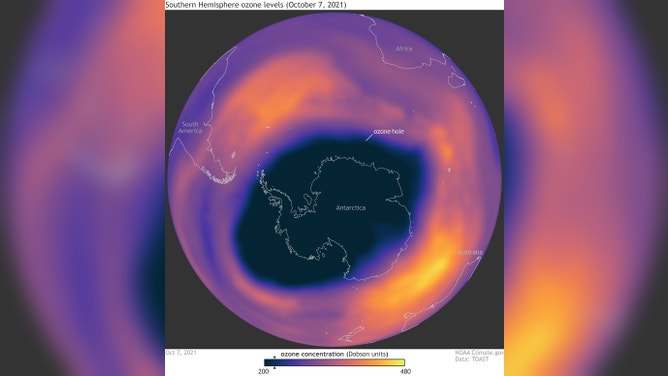
"This visualization depicts the ozone hole over Antarctica at its maximum extent on October 7, 2021. Scientists define the "ozone hole" as the area in which ozone levels are depleted below 220 Dobson Units (dark blue, marked with black triangle on color bar)." Climate.gov
One of the largest and deepest since record-keeping began about 40 years ago, a record long-lasting ozone hole occurred in 2020 over Antarctica between August and September. The World Meteorological Organization blamed the severity of the hole on a strong, stable and cold polar vortex as well.
The 2021 hole was the 13th largest in recorded history, according to NOAA and NASA.
Travelers, take note and sunscreen down under
"Australia and New Zealand as well have a lot higher cases of penetration," said Akerman of the UV penetration through the atmosphere in Oceania, which has been linked to skin cancer. "And that's because, in the Southern Hemisphere, the ozone layer tends to be thinner than it does in the Northern Hemisphere."
Scientists measure ozone using balloons and satellites.
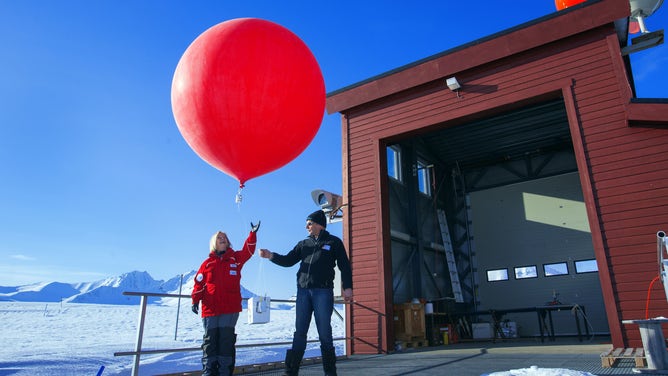
Scientists release a balloon with a radio and ozone sonde from an Arctic research base. The sonde takes measurements at different levels as it rises and sends back information.
(Photo by Jens Büttner/picture alliance via Getty Images / Getty Images)
All UV exposure increases a person's risk of developing skin cancer later in life. UV rays also contribute to cataracts. Check your UV index on the FOX Weather app.
STYLISH VS. PROTECTION: WHAT TO KNOW WHEN CHOOSING YOUR NEXT PAIR OF SUNGLASSES
"There have been studies that show that just having been exposed to sunburns as a child increases your risk of developing skin cancer later in life," said Akerman. "So the damage does accumulate over time. So you should always take precautions to protect your skin as well as you can whenever you go outdoors."
7 FACTS YOU NEED TO KNOW ABOUT THE UV INDEX TO KEEP YOU SAFE
UV radiation not only damages human organs, but nature is also affected as well.
"You can suppress growth cycles of plants or animals. Like plankton can be highly affected by UV rays, and plankton are at the bottom of the food chain for a lot of things in the ocean," said Akerman. "So you can change the environment around plants and animals, and that affects their regular cycles, which then can have wider-ranging impacts."
Ground level ozone
While stratospheric ozone protects life, ozone at the Earth's surface harms life. We think of low-level ozone as smog. You can check ozone and air quality on your local forecast page in the FOX Weather app.
